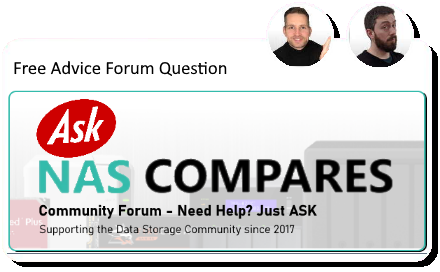Posts: 1,079
Threads: 1,080
Joined: Feb 2020
Reputation:
2
Hello, I would like to build a NAS. But I am a complete rookie at everything. I just looked up the meaning of NAS today and it's uses. Till now I have been saving my downloads on external HHDs but I've got three permanently attached to my computer and I am realizing that I needed a different solution.
I would like to start with Plex and I am also an avid gamer. For several games I use mods/cc. Think of Skyrim, Fallout and Sims 4. I try to never delete the mods/cc as a safeguard for myself and to share with others in the future. Still I would like to create and run a program that will help me automatically unpack, sort and organize these mods/cc in the future.
So my question is as someone who has no clue what she is doing, but is willing to learn. How can I create a NAS, make it growable and futureproof?
Posts: 5,338
Threads: 2
Joined: Jun 2022
Reputation:
35
Thanks for reaching out. You’re in a great spot to get started, and the fact that you’ve already identified Plex and mod storage as your main goals helps a lot with narrowing down the right approach.
Here’s how you can build a NAS setup that works for Plex, large file storage, and future automation—even as a beginner.
1. Start with a pre-built NAS-friendly mini server or motherboard
Since you’re new to this, I’d suggest avoiding complex custom builds for now. Instead, look at beginner-friendly NAS units like:
• Terramaster F4-424 or F4-423 – Affordable 4-bay NAS with good performance, upgradeable RAM, and easy to set up.
• UGREEN DXP4800 – Has a more modern interface and decent performance for home use, though still maturing in software.
• If you want to go DIY and grow into it: look at the Topton N100 motherboard (or a Beelink mini-PC with SATA support) with an ITX NAS case like the Jonsbo N2.
2. Use OpenMediaVault or UnRAID
These platforms are beginner-friendly and let you:
• Store and stream Plex media easily.
• Add new drives later (UnRAID makes this super simple).
• Run Docker apps to help with automation—like unpacking, sorting, renaming your mod downloads automatically using tools like FileBot, Sonarr, or custom scripts.
3. Start with 2–3 drives and expand
You don’t need to hit 60TB from day one. Get two 12TB or 16TB drives (WD Red Plus or Seagate IronWolf) and run them in a mirrored or UnRAID parity setup. You can expand as needed later with more drives or larger ones. Just make sure you use a 4 or 6-bay chassis from the start.
4. Automation and Sorting
Once the NAS is running, you can:
• Set up watch folders for downloads (e.g., from your PC or torrent client).
• Run automated scripts or Docker containers that extract, rename, and sort content (mods, videos, etc.).
• Use Plex to stream your media across your home.
5. Keep it futureproof
• Choose a case with at least 4–6 drive bays.
• Use a motherboard with at least 2.5GbE (network speed helps for large files).
• Leave room to add RAM (8–16GB is a good start).
• Don’t worry about full RAID setups if you use UnRAID—it lets you mix drive sizes and expand gradually.
Rough build idea within budget:
• Topton N100 ITX motherboard (~€140)
• Jonsbo N2 case (~€90)
• 8GB DDR4 RAM (~€30)
• 120GB SSD boot drive (~€20)
• 2x 12TB HDDs (~€400 total)
• Small power supply (~€60)
This leaves room in your budget to grow, and gives you an expandable NAS you’ll understand and control. Once you’ve got it built, we can walk you through installing the OS and setting up Plex and your mod automation.





